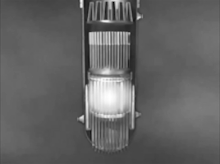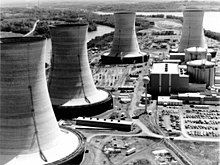
Back नाभिकीय गलाव ANP انصهار نووي Arabic Fusió de nucli Catalan Roztavení reaktoru Czech Toddiad niwclear Welsh Kernenedsmeltning Danish Kernschmelze German Πυρηνική κατάρρευση Greek Fusión de núcleo Spanish Nukleoaren fusio Basque



A nuclear meltdown (core meltdown, core melt accident, meltdown or partial core melt[2]) is a severe nuclear reactor accident that results in core damage from overheating. The term nuclear meltdown is not officially defined by the International Atomic Energy Agency[3] or by the United States Nuclear Regulatory Commission.[4] It has been defined to mean the accidental melting of the core of a nuclear reactor,[5] however, and is in common usage a reference to the core's either complete or partial collapse.
A core meltdown accident occurs when the heat generated by a nuclear reactor exceeds the heat removed by the cooling systems to the point where at least one nuclear fuel element exceeds its melting point. This differs from a fuel element failure, which is not caused by high temperatures. A meltdown may be caused by a loss of coolant, loss of coolant pressure, or low coolant flow rate or be the result of a criticality excursion in which the reactor is operated at a power level that exceeds its design limits. Alternatively, an external fire may endanger the core, leading to a meltdown.
Once the fuel elements of a reactor begin to melt, the fuel cladding has been breached, and the nuclear fuel (such as uranium, plutonium, or thorium) and fission products (such as caesium-137, krypton-85, or iodine-131) within the fuel elements can leach out into the coolant. Subsequent failures can permit these radioisotopes to breach further layers of containment. Superheated steam and hot metal inside the core can lead to fuel–coolant interactions, hydrogen explosions, or steam hammer, any of which could destroy parts of the containment. A meltdown is considered very serious because of the potential for radioactive materials to breach all containment and escape (or be released) into the environment, resulting in radioactive contamination and fallout, and potentially leading to radiation poisoning of people and animals nearby.
- ^ Martin Fackler (1 June 2011). "Report Finds Japan Underestimated Tsunami Danger". The New York Times.
- ^ Commission, U. S. Nuclear Regulatory; Rasmussen, Norman C. (18 June 1975). "Reactor Safety Study: An Assessment of Accident Risks in U.S. Commercial Nuclear Power Plants". W.S. Hein – via Google Books.
- ^ International Atomic Energy Agency (IAEA) (2007). IAEA Safety Glossary: Terminology Used in Nuclear Safety and Radiation Protection (PDF). Vienna, Austria: International Atomic Energy Agency. ISBN 978-92-0-100707-0. Retrieved 17 August 2009.
- ^ United States Nuclear Regulatory Commission (NRC) (14 September 2009). "Glossary". Website. Rockville, Maryland, USA: Federal Government of the United States. pp. See Entries for Letter M and Entries for Letter N. Retrieved 3 October 2009.
- ^ "Definition of MELTDOWN". merriam-webster.com.